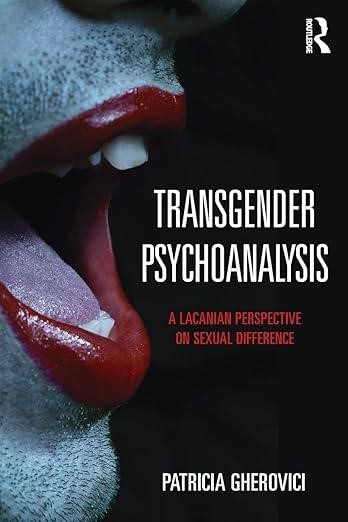
Reviewer: Sneha Biswas
(Instagram: @sneha_wish )
Title: Transgender Psychoanalysis: A Lacanian Perspective on Sexual Difference
Author: Patricia Gherovici
Genre: Non-Fiction/ Gender Studies/ Trans Studies
Language: English
Year: 2017
Publisher: Routledge
Pages: 328
Price: $ 34.95
ISBN: 978-1-138-81868-2
Amidst the unceasing debate and anxieties of our civilization on the phenomena of trans-sexuality, the contemporary gender discourse in academia and popular culture has accommodated trans-ness within a vigorous psycho-social constitution beyond the biological binary of man/woman sex. Freud’s psychoanalysis gave us a theory of sexuality foredoomed to seek resolution within the oedipal binary of sexual difference. It is the oedipal binary, where psychoanalysis traditionally located sexuality, which consequentially developed into a tendency to interpret transsexuality as a deviation or pathology. The writer of this book, Patricia Gherovici, who is also a practicing Lacanian psychoanalyst, aims to resolve the long-standing disjunction between psychoanalysis and transsexuality. Indeed, she offers a perspective where Lacanian psychoanalysis can well accommodate the particularities of multiplicities of trans-experiences using Jacques Lacan’s psychoanalytic theories of what I would like to call ‘sex-ed subjectivity’.
The book begins with the proclamation and affirmation that we are living through an age of the “transgender moment” marked by the omnipresence and hypervisibility of multifarious embodiments of transsexuality in worldwide media culture and societies. There is an obvious commercialization, capitalization, and relentless consumption of the image of such trans-experiences as seen in today’s global media, showbiz, events, celebrity, and popular culture.
Yet, there has not been an actual understanding beyond a ‘sensationalist’ and superficial public interest. Gherovici calls out such modes of engagement and engages in an intricate dissection of the trans-experience by positioning herself within a much unadulterated and pure psychoanalytic theoretical framework that is strictly Freudo-Lacanian at its best.
She distances herself from Catherine Millot’s argument which pathologizes transsexuality as “psychosis” which has been the problematic historical position of psychoanalysis since Millot’s time and carefully generates an innovative theoretical framework around the Lacanian concept of sinthome in reading the trans-experience.
The book is divided into nineteen short chapters of succinct passages, each chapter guiding the reader through a constructive explanation of the propositions the writer makes in the book. Operating boldly from an iconoclastic standpoint to bring forth a harmony between the (trans)gender discourse with psychoanalysis, Gherovici does not shy away from anything and engages with all sides of the trans-experience.
The first chapter “Transamerica” begins with her discussion of the American celebrity culture around Caitlyn Jenner’s transition where she raises the utterly controversial topic of Rachel Dolezal’s claim of trans-racialism, then moves forward in the following chapters to thoroughly expound on the provocative theories of sexuality by Freud and fully utilizes the Lacanian concepts of ‘formulae of sexuation’ and sinthome to advocate for the transient and “artificial” nature of transsexuality.
With the notion of trans-artificiality comes the evident topic of the body and surgical modifications, which Gherovici emphasizes, is not a “cure” as transsexuality is not a pathology but an unconscious logic of positioning oneself as a sexed being within the two modes of enjoyment (the Lacanian jouissance ) postulated in Lacan’s formulae of sexuation from his 1972-1973 Seminar.
This ‘unconscious sexed positioning’ is what Gherovici refers to as gender identification which is neither a pure biological essentialism as suggested in the medical discourse nor an social construct as spearheaded by the Butlerian gender discourse, but a ‘solution’ to the fundamental “sexual non-rapport”. Gherovici suggests that in the case of the trans-subject, body modifications and surgical interventions in reconstructing the given body (real) into the preferable ideal body (body image) produces the biding knot of the sinthome which serves as the ‘solution’ that makes life livable by carving out a characteristically singular form of identity for the trans-subject.
Given that the book is densely theoretical and heavily oriented in the Freudo-Lacanian discourse, there is no escape from the impervious terminologies of core Lacanian essentials—jouissance, sexual difference, sexual non-rapport, formulae of sexuation, sinthome—but Gherovici is careful in explaining them in the simplest terms, using demonstrative case studies, making the reading suitable for all including the unacquainted. Many of the chapters delve into the most unpalatable Freudian concepts—polymorphous perversity of human sexuality, the death drive and the anal drive, the hysteric’s bisexual disposition—which are made accessible by the writer, and succinctly put to use in favour of, and to explain transsexuality.
It is Lacanian hysteria that Gherovici particularly chooses over psychosis to elucidate the condition of the trans-subject where gender choice is tantamount to the hysteric’s question “Who am I?” It is therefore a matter of existence, identification, and subjectivisation of self-hood which is a universal ordeal for not just trans-subjects but for all.
Building on this in Chapter 8, Gherovici explores the common phenomenon of experiences of “trance” states in trans-subjects. She designates the cause of such hypnotic dream-like states as an ecstatic excess of jouissance derived from the eroticized hysteric’s position vis-à-vis knowledge production, as articulated in Lacan’s hysteric’s discourse. By this logic, the trans-experience no longer remains the Freudian symptom as repressed messages in the unconscious but becomes a radical epistemic category.
It is compelling how Gherovici uses the formulae of sexuation to open up a significant space for the trans-subject to thrive within the psychoanalytic discourse by allowing a position outside the deadlock of the Freudian Oedipal model of the man/woman binary of sexual difference and offering with an exceptional position of a not-all mode of enjoyment beyond the normative embodiment in relation to the signifier of the phallus.
From this singularity of the not-all, Gherovici shifts her emphasis to Lacan’s conjecture of the Joycean sinthome as her key proposition in the text. Following Lacan’s mirror stage, she elaborates how the process of embodiment has to occur for each individual where the creation of the “ego” parallels with the libidinal investment in the body image. It is understandable how the ‘synthetic’ nature of the process of embodiment may produce gaps/holes where the disjunction between the real body and the body image becomes apparent to the individual—a condition that Gherovici mentions to have found in all her analysands with trans-experience.
The ‘hole’ in embodiment manifests as the ‘problem’ with/of the body requiring a solution where the sinthome appears to fit in perfectly well. In chapter 16 “The Art of Artifice”, Gherovici situates the sinthome within the domain of creativity using the example of Swift Shuker’s documentation of their transition from a male body to an androgynous one in their video performance, This Damned Body. Gherovici elaborates on how the entire process of transforming the body can serve as an art form by facilitating a ‘creative writing’ of the ‘new body’, thus working as a body-constructing device that provides a binding knot to hold and (con)firm the embodiment, and a permanence of meaning and stability to the psychic reality of the subject.
This ‘constructive’ aspect of bringing into existence what is not there—constructing a presence in place of a gap— corresponds with the idea of the “plastic” body as is true for transexual artificiality. This art of ‘writing the body’ is the Joycean sinthome which works as a permanent solution to the non-rapport of the actual body and the body-image in trans-individuals. In the following chapter, we learn about the sinthome as Lacan’s repurposing of the Lucretian clinamen which necessitates a push towards a newer path of ‘becoming’ by breaking the inertia of repetition. When such deviations lead to something truly creative and singular, they take on the significance of a sinthome—whether in literature, art, or the (re)construction of the body. In the case of the trans-individual, the sinthome is the active construction of a desirable new body. Sinthome as ‘body construction’ is to be understood as an intuitive rendering of a consistent body-image that the individual can mentally refer to as their own by actively making visible changes in the body through cosmetics, fashion, or/and surgical intervention. Thus sinthome becomes a creative departure from the impasse of the perpetual body-trouble which radically brings about a dynamic existence of the subject.
The writer concludes the closing chapter “Coda” with an open-endedness where she mentions Lacan’s invocation of Tiresias’s mythical hermaphrodite figure to draw parallels with the position of the analyst, who must understand the subjective modes of enjoyments (jouissance) that do not adhere to the logic of the norms of sex and gender.
That psychoanalysis is itself a practice oriented around a trans-ness of the knowledge of sexuality, the singular, the subjective, should not be lost on us. By the end of the book, the readers might be intrigued by the inherent queerness and originality of undiluted Freudo-Lacanian psychoanalysis and its remarkable compatibility with contemporary queer and gender discourses.
The book has the potential to foster a desire for Freudo-Lacanian psychoanalysis in the readers’ minds through its careful explanation of the theories substantiated by plentiful compelling narratives of lived lives. From the ancient Greek atomist theories of Lucretius and Democritus to modern-day Lady Gaga—you have it all contextualized with ample interesting clinical case studies, contemporary art, classical philosophy, and literature directly correlated with gender and sexuality.
Even if you are not convinced about psychoanalysis by the end of the book, you certainly shall enjoy the high ride!
~
You can purchase the book here.
Sneha Biswas is an art practitioner and researcher, thoroughly engaged in the intersections of visual arts, critical thinking, and psychoanalysis. She has a BA in English Literature from Calcutta University (2015-2018) and an MFA in Art History from Kala Bhavana, Visva Bharati University (2020-2023). She is pursuing her second MA in English Literature from Jadavpur University (2023-ongoing). She hopes to blissfully spend the later years of her life making art and writing; perhaps she might run a magazine in time!

Subscribe to our newsletter To Recieve Updates
Join our newsletter to receive updates